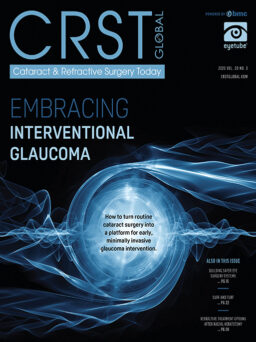No one wants to encounter vitreous during routine cataract surgery. Understanding the principles behind safe and effective vitrectomy is critical for all cataract surgeons. This month, I am honored to have my partner Samantha Schockman, MD, review the essentials of vitrectomy for the anterior segment surgeon. Dr. Schockman specializes in complex cataract surgery and anterior segment reconstruction at the Cincinnati Eye Institute. In this article, she shares her pearls for managing vitreous prolapse and loss.
—Kavitha R. Sivaraman, MD

Vitreous prolapse and loss in cataract surgery are often unanticipated. These complications are commonly diagnosed intraoperatively, leaving the surgeon to determine management on the fly. Unfortunately, vitreous loss is associated with poorer visual outcomes due to related complications, including cystoid macular edema, retinal detachment, and endophthalmitis.1,2
The rate of vitreous loss during cataract surgery varies across studies but ranges from 0.45% among more experienced surgeons to 14.7% among less experienced surgeons.3 All surgeons will encounter this intraoperative complication, so it is advantageous to learn to identify and manage vitreous loss to optimize patient outcomes.
RISK FACTORS
It is not always possible to know when vitreous prolapse and loss will occur. Several preoperative risk factors can help identify patients at increased risk. Any disease or iatrogenic process that results in a poor surgical view, weakened or broken zonules, or a violated posterior capsule increases the risk of vitreous prolapse. Risk factors include, but are not limited to, prior trauma, use of alpha-1 adrenoceptor antagonists, pseudoexfoliation, high myopia, connective tissue disorders, prior vitrectomy, short axial length, positive posterior pressure, and a dense or posterior polar cataract.
Identifying patients at increased risk for vitreous prolapse and loss before surgery allows adequate preparation and permits the OR staff to have proper equipment on standby.
Five fundamentals for intraoperative optimization are outlined below, followed by a section on advice for prophylaxis to prevent complications.
1. Identify vitreous prolapse early. Identify vitreous prolapse as early as possible to avoid a cascade of complications.
Vitreous prolapse that goes unnoticed can result in retinal tears and detachments from vitreous traction if surgery continues without proper precautions. Be vigilant for subtle changes that indicate a posterior capsular break and subsequent vitreous prolapse or loss. Changes include a sudden deepening of the anterior chamber, abnormal pupillary movements, an inability to rotate a previously mobile lens, the posterior displacement of lens fragments, tilting of the nuclear equator, and the presentation of vitreous in the anterior chamber. Dilute triamcinolone acetonide can be instilled to help visualize the vitreous if its presence is suspected.
2. Maintain chamber stability. Do not panic in the face of vitreous prolapse. Focus on maintaining a stable eye. Removing instrumentation without first injecting an OVD creates a posterior-to-anterior pressure gradient, potentially causing vitreous expulsion into the anterior chamber and vitreous loss through the limbal wounds.
It is critical to prevent anterior chamber collapse and to maintain pressurization for the remainder of the cataract procedure. A dispersive OVD can be instilled to tamponade the vitreous and prevent an unfavorable pressure gradient before instruments are removed. It is important to suture wounds that do not self-seal adequately.
3. Perform a safe and effective vitrectomy as needed. Once the eye is stable, assess the extent of vitreous prolapse and plan for a vitrectomy if needed. There is some debate whether anterior segment surgeons should perform an anterior vitrectomy via a limbal or pars plana incision. In either scenario, the goal is to minimize vitreous traction while safely removing vitreous. This is achieved by separating infusion from the vitrector and using the highest cut rate available with a low aspiration rate. Avoid creating unnecessary traction on the vitreous—do not sweep the wound with a spatula or apply a Weck-Cel sponge (BVI Medical) to the wound.
The advantage of a pars plana approach is the posterior position of the vitrector relative to the prolapsed vitreous and anterior chamber infusion. Positioning the vitrector posteriorly pulls the vitreous back, minimizing disturbance of a ruptured posterior capsule and facilitating safe and complete vitreous removal. A limbal approach places the vitrector anteriorly, which pulls the vitreous upward. Anterior movement of the vitreous can extend the tear in the posterior capsule and place traction on the vitreous base. I favor a pars plana approach, but a limbus-based vitrectomy is warranted under some circumstances. For example, a small, isolated vitreous whisp in the anterior chamber may be safely removed with a limbus-based vitrectomy.
4. Remove remaining lens material safely. Nuclear pieces should be carefully elevated into the anterior chamber using an OVD. The iris can be used as a scaffold until the vitrectomy is complete. Nuclear pieces can then be removed as whole fragments through enlarged incisions or by reintroducing the phaco probe after an IOL is placed. In the latter scenario, the IOL acts as a barrier to prevent additional vitreous prolapse during phacoemulsification and to keep the nuclear pieces in the anterior chamber.
Do not fish for lens fragments in the vitreous. Doing so is associated with a high rate of giant retinal tears and detachments.4 Leave lens pieces in the vitreous for a retina surgeon to remove with a pars plana vitrectomy and lensectomy.
Cortical cleanup can be performed with a dry aspiration technique using a cannula or with the vitrector’s irrigation/aspiration/cut setting. Viscodissection can also be a useful technique when cortical material adheres to the capsule and is difficult to remove.
5. Place an IOL appropriately. Implant the IOL, if possible, to speed the patient’s postoperative visual recovery and spare them a secondary procedure. The location and type of IOL are dictated by the amount of capsule and zonular support remaining.
If the break in the posterior capsule is small and the strength of the zonules is adequate, then an IOL can, in some circumstances, be safely placed in the capsular bag, particularly if the posterior capsular opening is converted into a continuous posterior capsulorhexis.
If the break in the posterior capsule is large but the anterior capsule and zonules are intact, then a three-piece IOL can be placed in the sulcus. It is advantageous to capture the optic whenever possible to increase IOL stability and create a barrier against additional vitreous prolapse.
If placing an IOL in the sulcus raises concern about its stability and optic capture is not an option, then suture fixation to the iris or sclera can provide additional support.
If the capsule cannot provide sufficient support, then scleral fixation of the IOL may be required.
PROPHYLAXIS TO PREVENT COMPLICATIONS
At the end of the case, ensure that the IOL is stable, the wounds are watertight, and no vitreous remains in the anterior chamber. Miotics can be instilled intraoperatively to check for residual vitreous; a vitreous strand will result in a peaked pupil. Staining the anterior chamber with triamcinolone acetonide can help identify any residual vitreous.
Capsular breaks with vitreous prolapse increase the risk of endophthalmitis 14-fold.5 Consider instilling intracameral and/or subconjunctival antibiotics if available.
After surgery, perform a thorough dilated eye examination and look carefully for macular edema, retinal tears and retained lens fragments. Macular edema is more common in eyes after vitreous prolapse, but this may be mitigated by an extended postoperative course of NSAID and steroid drops. It is important to maintain a low threshold for early referral to a retina specialist if a retinal tear, retained lens fragment, or uncontrolled cystoid macular edema is identified.
CONCLUSION
Every anterior segment surgeon will face unplanned vitreous prolapse and loss during cataract surgery. Despite association with poorer visual outcomes, patients with this complication can still do well if managed appropriately.6 Early recognition and minimization of vitreous traction intraoperatively are critical for success.
1. Tan JHY, Karwatowski WSS. Phacoemulsification cataract surgery and unplanned anterior vitrectomy: Is it bad news? Eye (Lond). 2002;16(2):117-120.
2. Blomquist PH, Rugwani RM. Visual outcomes after vitreous loss during cataract surgery performed by residents. J Cataract Refract Surg. 2002;28(5):847-852.
3. Jacobs PM. Vitreous loss during cataract surgery: prevention and optimal management. Eye (Lond). 2008;22(10):1286-1289.
4. Aaberg TM, Rubsamen PE, Flynn HW, et al. Giant retinal tear as a complication of attempted removal of intravitreal lens fragments during cataract surgery. Am J Ophthalmol. 1997;124(2): 222-226.
5. Durand ML. Endophthalmitis. Clin Microbiol Infect. 2013;19(3):227-234.
6. Ang GS, Whyte IF. Effects and outcomes of posterior capsule rupture in a district general hospital setting. J Cataract Refract Surg. 2006;32(4):623-627.






